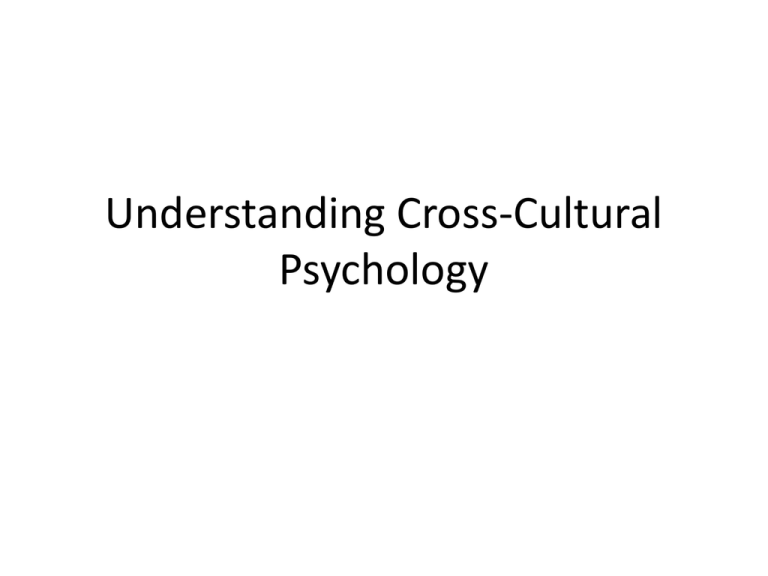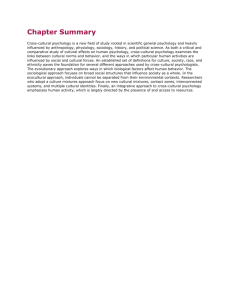Understanding Cross-Cultural Psychology
advertisement

Understanding Cross-Cultural Psychology What is Cross Cultural Psychology? • The critical and comparative study of cultural effects on human psychology – Comparative field-requires two groups to compare at all times – Examines: • Psychological Diversity- why all behavior isn’t the same in every culture • Interactions- how does the diffusion of one culture into another for a period influence that culture later • Establishes Psychological Universals- commonalities amongst all people What is cultural psychology? • Cultural Psychology seeks to discover meaningful links between a culture and the psychology of individuals living in the culture – Looks to understand whether, when and how individuals growing up in a culture internalize that culture’s qualities – Mental processes are essentially the products of an interaction between culture and the individual Culture • A set of attitudes, behaviors and symbols shared by a large group of people and usually communicated from one generation to the next – Attitudes include- beliefs, values, general knowledge, opinions, superstitions, and stereotypes – Behaviors include variety of- norms, roles, customs, traditions, habits, practices, and fashions – Symbols may include- material objects, colors, sounds, slogans, buildings, etc. • Cultures possess implicit and explicit characteristics – Explicit- set of observable acts regularly found within the culture – Implicit-organized principles that are inferred to lie behind these regularities on the basis of consistent patterns of explicit culture • No society is culturally homogeneous Race, Ethnicity, Nationality • American Terms – Race- a group of people distinguished by certain similar and genetically transmitted physical characteristics • Some believe once centered on geographical isolation, now political, cultural or religious factors are seen as more important • Some argue race is simply a social category – Ethnicity-cultural heritage – Nation- people who share common geographical origin, history and language • Not all cultures use these terms in the same way which can make things confusing. • Never forget groups are constantly changing, particularly in the United States. Knowledge in Cross-Cultural Psychology • • • • Scientific Knowledge-research based Popular Knowledge-Everyday assumptions Ideological Knowledge-Based on set of beliefs Legal Knowledge- encapsulated in law Traditional vs. Non-Traditional Culture Traditional Non-Traditional (Modern) Social Roles prescribed Social Roles are achieved Emphasis of individual behavior placed on Emphasis of individual behavior placed customs and routines on personal choice Clear distinction between good and evil Distinction between good and evil is relative Truth is not debatable Truth comes from competition of ideas Individual Choices are restricted to boundaries of social prescriptions Individual Choices not restricted to boundaries of social prescriptions Empirical Examination of Culture • Cultural differences can be classified in terms of cultural dichotomies – Power Distance-extent to which members of a society accept power in institutions and organizations is distributed unequally • High-accepting of inequality • Low-reject inequality – Masculinity vs. Femininity • Masculinity-focus on work goals, earning and advancement • Femininity-focus on values of modesty and caring for the weak – Uncertainty Avoidance-degree to which members of a society feel uncomfortable with uncertainty and ambiguity • High-promote Certainty/Conformity • Low-non-conformist – Collectivism vs. individualism-focus on the group vs. focus on self Further Research with Individualism and Collectivism • Vertical and Horizontal concepts – Vertical-people refer to each other from power and achievement standpoints – Horizontal-Benevolence and equality Cultural Syndromes • The pattern or combination of shared attitudes, beliefs, categorizations, definition, norms, and values that is organized around a theme that can be indentified among those who speak a particular language, during a specific historic period, in a definable geographic region. • Types – Tightness-rules and norms applied to social situations and sanctions applied to those who violate the norms – Cultural complexity-a number of different cultural elements and their activity or passivity – Honor- combo of attitudes and practices that support aggressive actions in the name of self-protection – Collectivism vs. Individualism – Egalitarian-vertical and horizontal relationships Approaches to examine human activity in cultural settings • Sociobiological Approach-Social Darwinism-natural and evolutionary explanations offered for a wide array of human behavior • Sociological Approach-Broad social structures influence society as a whole , and subsequently its individuals • Ecocultural Approach-Environment has effect on individual and individual in turn effects the environment • Cultural Mixtures Approach-Cultures are constantly moving and mixing (Biculturalism vs. Fundamentalism) • Integrative Approach-Combining these ideas with a focus on Activity and Availability of Resources Indigenous Psychologies • Scientific study of human behavior that is designed for a people and native not transported Ethnocentrism • A view that supports judgment about other ethnic, national and cultural groups by observing them from the standards of your own group. Multiculturalism • A movement to support the view that all cultural groups have the right to follow their own unique paths of development and have their own unique activities, values and norms



